Fantasy Hockey Draft Strategy That Wins Leagues
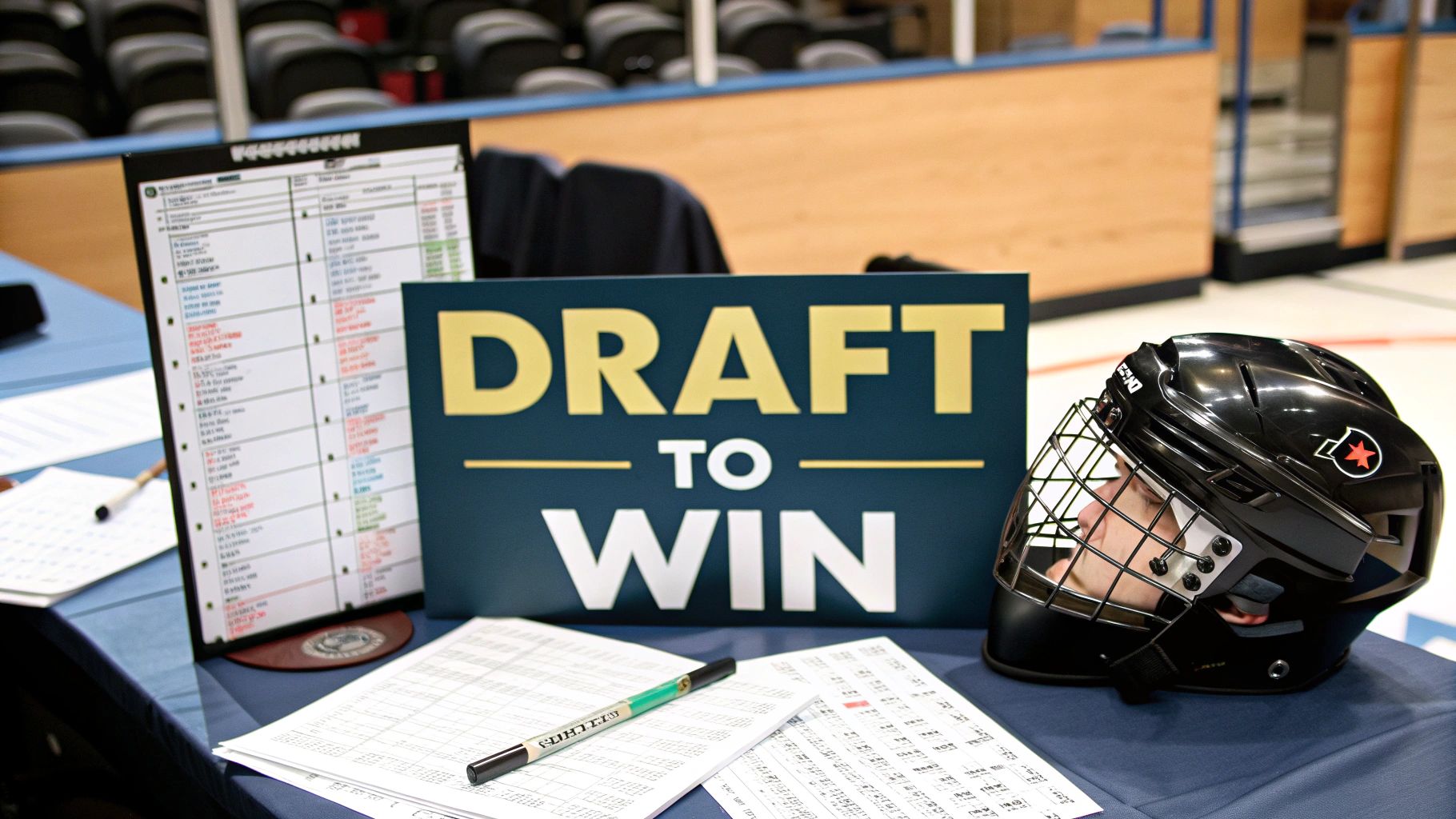
A winning fantasy hockey draft is built long before you ever join the draft room. It’s all about the prep work—digging into your league’s specific rules, ditching generic player rankings, and having a flexible plan ready for the big day. This is the stuff that separates the league champs from everyone else.
Laying the Groundwork for a Winning Draft
Your fantasy hockey championship isn’t won with a lucky pick in the fifth round; it’s won in the weeks leading up to the draft. The managers who consistently finish at the top are the ones who put in the time, turning the draft from a frantic guessing game into a calculated strategy. It’s less about predicting the future and more about building a solid framework you can adapt on the fly.
It all starts with dissecting your league's settings. Don't just skim them—live them, breathe them. How your league scores points and structures its rosters completely changes who you should be targeting.
Decoding Your League's DNA
A player who’s a stud in a standard points league might be just another guy in a bangers league that rewards hits and blocked shots. Think about it: a pure goal-scorer like Auston Matthews is a top-tier asset anywhere, but someone like Brady Tkachuk becomes a monster in leagues counting shots, hits, and PIMs. His production across multiple categories can single-handedly win you weeks.
To really get a feel for your league's landscape, ask yourself these questions:
- Scoring System: Is it Head-to-Head (H2H) Categories, H2H Points, or Rotisserie (Roto)? A power-play specialist, for instance, loses a ton of value if your Roto league doesn't have a specific PPP category.
- Valued Categories: Does your league count peripheral stats like hits, blocks, faceoff wins, or penalty minutes? This is where you find the biggest gaps between a player's real value and their public perception.
- Roster Composition: Are there specific positional requirements (e.g., 2C, 2LW, 2RW vs. 4F)? Positional scarcity is real. If quality right-wingers are shallow, you might need to grab one earlier than a generic ranking sheet would ever tell you to.
Key Takeaway: Never, ever trust a generic ranking sheet. Your league's settings are the only source of truth. Building your own rankings based on those rules gives you a massive advantage over opponents who just show up with a default list.
The Power of Player Tiers
Once you know what makes a player valuable in your league, it's time to build tiers. Forget a rigid list of players ranked 1-to-200. Instead, group players of similar projected value together. This is an absolute game-changer for making decisions under pressure.
Tiering helps you see the draft board in terms of value cliffs. You’ll know exactly when the last "Tier 1" defenceman is on the board or when the "Tier 2" goalies are about to dry up. This stops you from panic-picking and helps you grab the best player available in every round. If you see just one guy left in a high-value tier, you know it's time to pounce—even if it feels a round "too early."
Practice Makes Perfect with Mock Drafts
All this prep work needs a test run. Mock drafts are your scrimmages, and they are essential for getting a feel for draft flow and Average Draft Position (ADP). Hopping into a few mocks lets you:
- Test different strategies: Try a forward-heavy approach in one mock, then go for an elite goalie early in another. See what feels right.
- Identify value at your draft slot: You'll start to see which players consistently fall to you at your pick.
- Anticipate your opponents: Pay attention to when positional runs start. Learn when to zig while everyone else zags.
Walking into your draft unprepared is like showing up to an exam without studying. By digging into the rules, creating custom tiers, and pressure-testing your plan in mocks, you'll arrive cool, confident, and ready to build a championship roster from the ground up.
Evaluating Players Like a Pro Scout
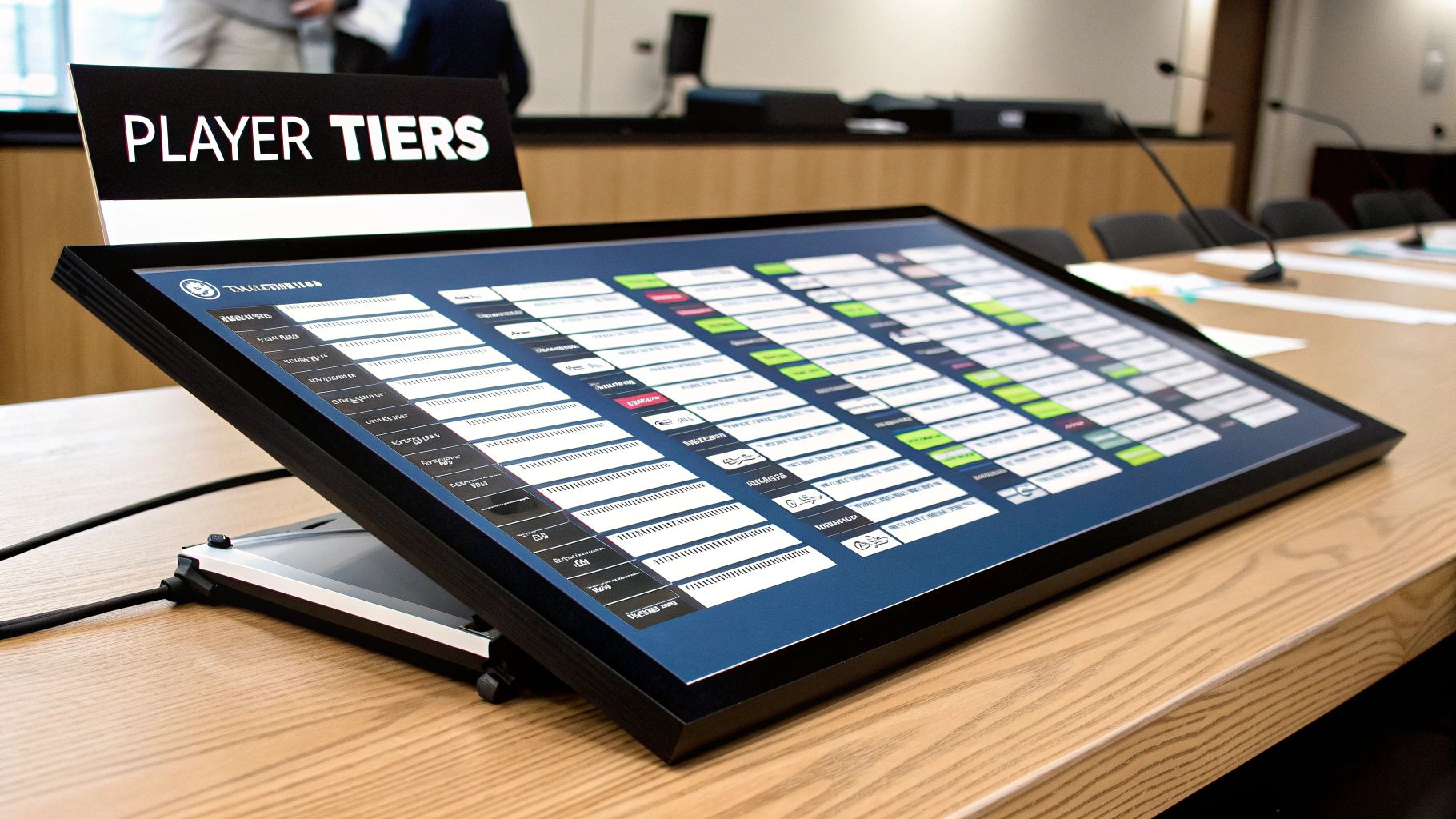
If you want a real edge in your fantasy hockey draft, you have to stop looking at last year's final standings and start thinking like a scout. Relying on a player's previous season point totals is one of the biggest mistakes managers make. It's just a snapshot of the past, not a reliable map of the future.
True player evaluation means digging into the numbers behind the numbers. These metrics tell the story of how a player scored, helping you figure out if their performance was legit or just a lucky streak.
The Power Play Goldmine
Let's get straight to it: the single most important factor for offensive production is a player's role on the power play. A spot on the top unit is fantasy gold. It’s that simple. This is where you find guys who can single-handedly win you a week.
Power Play Time on Ice (PP TOI) has become a non-negotiable metric. Players with high PP TOI are just flat-out more likely to rack up points, especially since teams score on roughly 19.1% of power plays across the NHL. Targeting players who log top-tier power play minutes can boost their fantasy output by 25-30%.
Pro Tip: When you're looking at player lists, filter them by PP TOI. Any forward getting over three minutes per game with the man advantage is a prime candidate for a production jump, even if their 5-on-5 numbers look just okay.
This is what separates savvy managers from the pack. Talent is great, but opportunity is what cashes the cheques in fantasy hockey.
Spotting Red Flags and Bounce-Backs
Beyond power-play time, you need to know if a player's season was built on a solid foundation or a house of cards. Two stats will tell you almost everything you need to know: Shot Volume (SOG) and Shooting Percentage (S%).
- Shot Volume (SOG): This is the engine. A player who consistently fires 250+ shots on goal has a stable floor. Even if his luck runs cold for a bit, the sheer volume will eventually create goals.
- Shooting Percentage (S%): This is where you find the luck, good or bad. Most elite forwards hover between 10-15% for their careers. If a player scored 35 goals on an 18% shooting percentage last year, alarms should be going off. That's a classic negative regression candidate. On the flip side, a high-volume shooter with a weirdly low 7% S% is probably due for a massive bounce-back.
Here is a quick look at some key advanced stats that can give you an edge in player evaluation.
Key Advanced Metrics for Player Evaluation
| Metric | What It Tells You | Why It Matters for Fantasy |
|---|---|---|
| Corsi For % (CF%) | Measures shot attempt differential while a player is on the ice at 5-on-5. A CF% above 50% means their team controls the puck more often with them on the ice. | High CF% players spend more time in the offensive zone, leading to more scoring chances, shots, and assists. It's a great indicator of sustainable production. |
| Individual Points Percentage (IPP) | The percentage of on-ice goals a player earned a point on. For top forwards, this number is usually around 70-80%. | A low IPP for a skilled player suggests bad luck and potential for a rebound. A sky-high IPP (90%+) might signal that their point totals are inflated and due to come down. |
| Zone Start Ratio (oZS%) | The percentage of non-neutral zone faceoffs a player takes in the offensive zone. | A high oZS% (over 60%) means a coach is deploying that player specifically to create offence. This is a huge green flag for future point production. |
Analyzing these stats helps you avoid overpaying for last year's hero whose success was a fluke. Instead, you can find incredible value by targeting guys who were just plain unlucky.
Finding This Year's Breakout Stars
Your draft isn't just about grabbing established names. It's about finding the next wave of top performers before your leaguemates do. This is where you can really win your league.
Look for players in these common breakout scenarios:
- The Promotion: A skilled young forward who was stuck on the third line last year is now pencilled in to skate with the team's top centre. More ice time with better players almost always equals more points.
- The New Power Play QB: A team moves its veteran point man on defence. Who's next in line? Find the younger, offensively-gifted blueliner set to take over that prime spot on the top power-play unit.
- The Change of Scenery: A talented player escapes a defence-first system and signs with a high-flying, run-and-gun team. That new environment alone could unlock another 15-20 points.
When you combine a little statistical analysis with an eye for changing team situations, you're no longer just drafting off a list. You're building a roster full of players set up for success. To get a head start, check out our comprehensive fantasy NHL rankings for 2025.
How to Approach Drafting Forwards and Defensemen
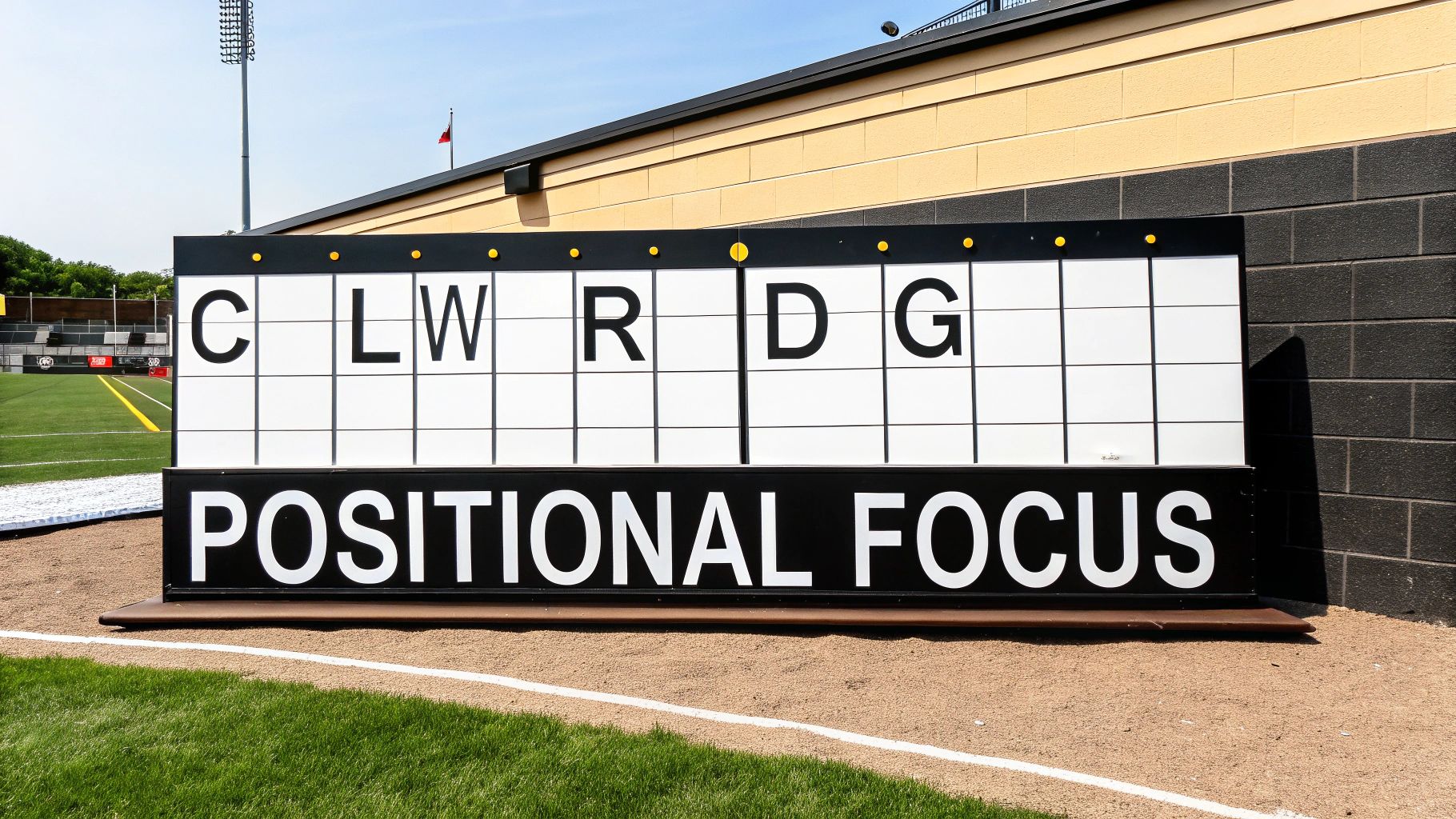
Once your tiers are locked in, the real draft-day chess match begins. The classic dilemma every manager faces is how to build out their skaters. Do you load up on high-scoring forwards early, or do you snag an elite, multi-category defenceman to anchor the blue line?
There’s no single correct answer, but your choice here will shape your team’s identity all season long.
A popular and generally safe strategy is going forwards-heavy in the early rounds. The logic is simple: forwards score the most goals and points, which are the bedrock of most fantasy leagues. Grabbing two or three elite point-producers right away gives your team a high offensive floor, making you competitive every single week.
The risk? If you wait too long on defencemen, the top tiers will be gone. You'll be left scrambling for blueliners who don't actively hurt you in categories like plus-minus.
The Contrarian Move: An Elite Defenceman Early
While most of your league zigs toward forwards, you can find a massive edge by zagging. Grabbing an elite, multi-category defenceman in the first or second round is a powerful move, especially in leagues that reward peripheral stats like hits and blocked shots.
Think about it this way: only a handful of D-men can produce like a top-30 forward. Players like Cale Makar and Roman Josi are unicorns. They deliver goals, assists, and power-play points that rival many first-line wingers, all from a position of scarcity. Locking one down gives you a positional advantage that's almost impossible to replicate later.
A defenceman who gives you 50+ points, 150+ shots, 100+ hits, and 100+ blocks is often more valuable than a forward who just gets you 70 points and little else. This balanced production can single-handedly win you multiple categories each week.
Finding Balance Between Positions
A championship draft isn't just about picking the "best player available." It’s about building a roster that competes across the board. You need a mix of pure goal-scorers, high-volume shooters, and physical players who chip in hits and blocks.
A smart way to build your skater group is to weave between positions based on your player tiers. For example:
- Round 1: Elite Forward (e.g., Nathan MacKinnon)
- Round 2: Top-Tier Defenceman (e.g., Quinn Hughes)
- Round 3: High-Volume Shooting Forward (e.g., Brady Tkachuk)
This approach ensures you don't fall behind at any position. You get your offensive anchor, your blue-line quarterback, and a multi-category beast all within the first three rounds.
The Rise of the Defence-First Strategy
An emerging draft strategy, particularly in competitive Canadian fantasy circles, flips the old script completely by targeting elite defencemen early and often. While it feels unconventional, the results speak for themselves. According to discussions on FantasyPuck, managers who prioritized defence in 2025 drafts consistently finished in their league's top three because these players offer such broad category coverage.
This strategy hinges on one key insight: while scoring forwards are relatively deep, true multi-category defencemen are incredibly rare. By securing two top-10 blueliners early, you can dominate defensive stats and then hunt for forwards with specific skills—pure goal-scorers, power-play specialists—in the mid-rounds.
You can often find undervalued forwards later on, and our guide on fantasy hockey sleeper picks is a great place to find those hidden gems.
Ultimately, you need to stay flexible. Watch the draft board, recognize when a run on a certain position is happening, and don't be afraid to pivot to scoop up incredible value. A balanced roster that can score, shoot, and hit is the key to building a championship contender.
Building a Reliable Goaltending Crew
Let's be honest: goaltending can either win you your fantasy hockey league or sink your season before it even gets going. Nailing your goalie strategy is non-negotiable.
A reliable tandem, or even a trio of goalies, is your ticket to weekly stability in wins, save percentage, and goals-against average. It’s the backbone of a championship roster.
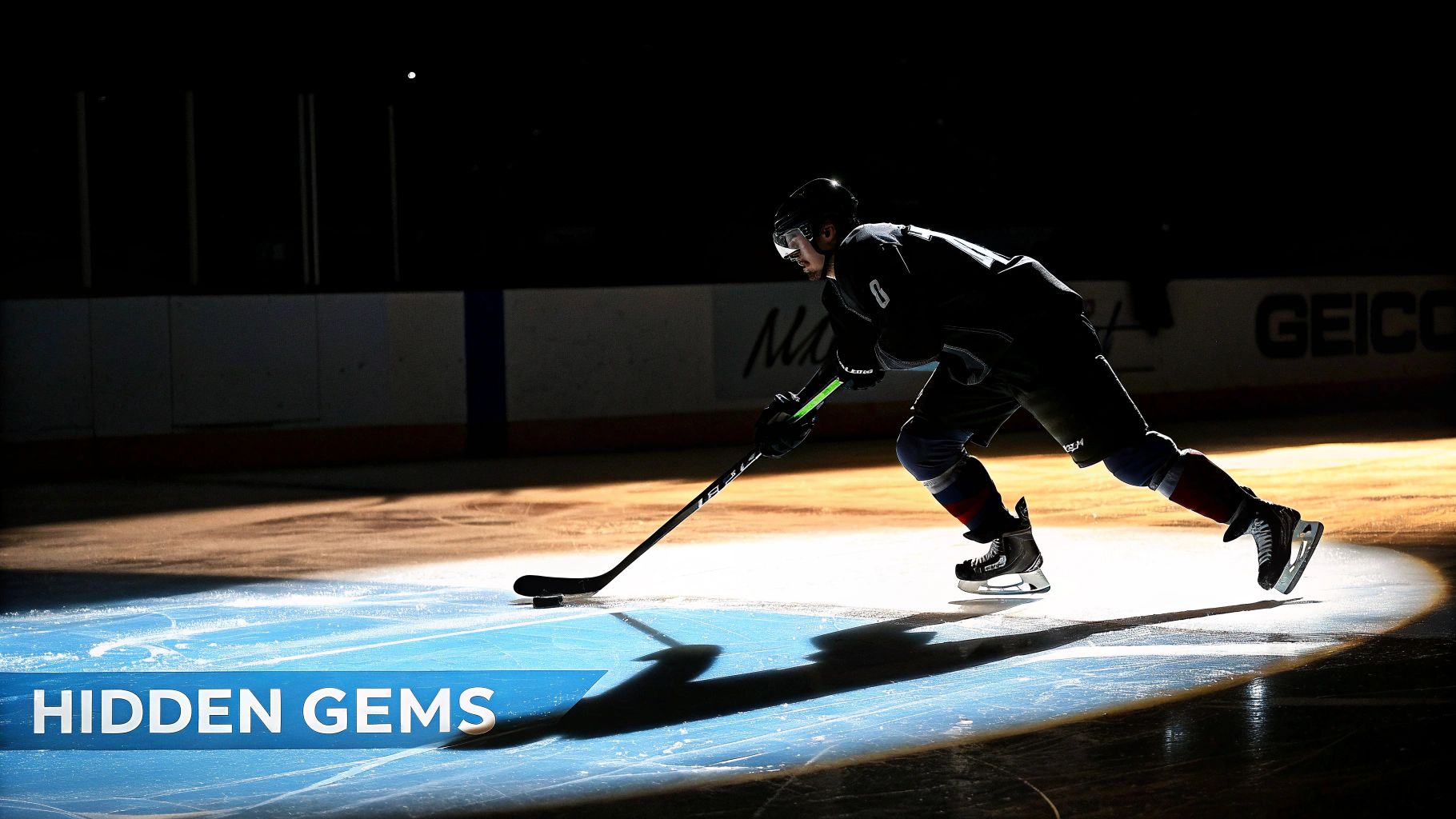
Some managers swear by grabbing an elite starter early. Others prefer to wait, hunting for value in the mid-rounds. And then there are the waiver-wire warriors, constantly streaming options. Each approach has its own risks and rewards, and knowing when to deploy each is key to dominating your head-to-head matchups.
- Grabbing an Elite Starter early anchors your season with a high workload and consistent wins.
- Targeting Mid-Round Value lets you build depth at other positions while still securing solid netminders.
- Streaming Goalies offers incredible flexibility but means you're constantly monitoring schedules and matchups.
Assessing Goalie Value
Don't just look at last year's win totals. A goalie's true value is a mix of their team's defensive strength, their personal save percentage, and their projected number of starts.
A high-volume starter on a defensively sound team is the holy grail—they can easily deliver a .915+ save percentage and a sub-2.40 GAA. Think about it: a goalie playing behind a top-tier defence just isn't going to face as many high-danger shots.
| Metric | What It Measures | Why It Matters |
|---|---|---|
| Save Percentage | Ratio of saves to shots | A high .915+ is a massive fantasy point driver |
| GAA | Goals allowed per game | Lower GAA almost always correlates with more wins |
| Games Started | Number of games begun | More starts simply mean more chances to rack up wins |
Use this kind of framework to compare your draft targets and spot where the value starts to drop off a cliff.
Elite vs. Mid-Round vs. Streaming
Spending a pick in the first three rounds on a workhorse starter guarantees you volume, but it comes at a steep price—you're passing on an elite skater. Is it worth it?
Mid-round netminders are often where championships are built. These guys can still give you 15-20 quality starts without costing you a top-tier draft pick. Streaming, on the other hand, is a high-effort, high-reward game. It requires you to be proactive on the waiver wire and an expert at reading schedules to find favourable matchups.
“In the 2023-24 and 2024-25 seasons, rostering three quality goalies improved success by 15-20%, a tactic every head-to-head manager should consider.”
We're seeing this trend more and more, especially in competitive Canadian leagues. Managers who embrace the three-goalie system, grabbing a guy like Jordan Binnington late who goes on a tear with a 5-1 record and a 2.12 GAA, are the ones who find consistent roster stability.
You can dig deeper into these trends and goalie values in this ESPN analysis.
Roster Construction Tips
My go-to strategy is to carry two stable starters and one high-upside option. This "trio" approach covers you for bye weeks, lets you ride hot streaks, and most importantly, limits the damage when one of your guys hits a cold spell.
- Do your homework: Research team defence quality before the draft to avoid goalies in high-risk situations.
- Monitor the backups: Keep a close eye on backup goalies playing for strong teams. They're prime streaming candidates.
- Watch the injury news: Be ready to pounce on emerging starters the second an injury happens—before the waiver claims flood in.
Balancing consistency with upside is the name of the game. A blend of an elite pick, a mid-tier gem, and a streaming spot gives you both safety and flexibility.
Monitoring Goalie Trends
The work isn't done after the draft. Stay ahead of your league mates by tracking goalie deployment, coaching changes, and team defensive upgrades. A new shutdown defenceman can totally change a goalie's outlook.
- Check preseason depth charts for any hints of a shift in the goalie hierarchy.
- Look at advanced stats like high-danger save percentage to see who is really playing well.
- Follow team acquisitions—a defensive upgrade might mean a drop in a goalie's workload but an increase in quality.
Just look at what happened in Calgary in early 2025. A veteran backup suddenly took over the starting role midseason, turning what was a tandem into a streaming goldmine for savvy fantasy managers who noticed the shift.
Consistent monitoring turns goaltending from a gamble into a genuine strength. Your crease should be a fantasy fortress, not a liability.
Navigating the Live Draft Environment
You've done the work. The hours of research, the endless mock drafts... they all lead right here. Your rankings are dialled in, your tiers are set, and you’ve got a game plan. But any fantasy vet will tell you the same thing: a draft never, ever goes according to plan.
The real key to turning all that prep into a championship roster is being able to adapt on the fly.
Staying cool under pressure is half the battle. Your top target will get sniped one pick ahead of you. A positional run will send your queue into chaos. The clock will feel like it's moving at double speed. This is where your tier-based rankings become your best friend, letting you pivot without panic and instantly spot the next-best value on the board.
This whole process is about connecting your pre-draft homework to your live draft decisions.
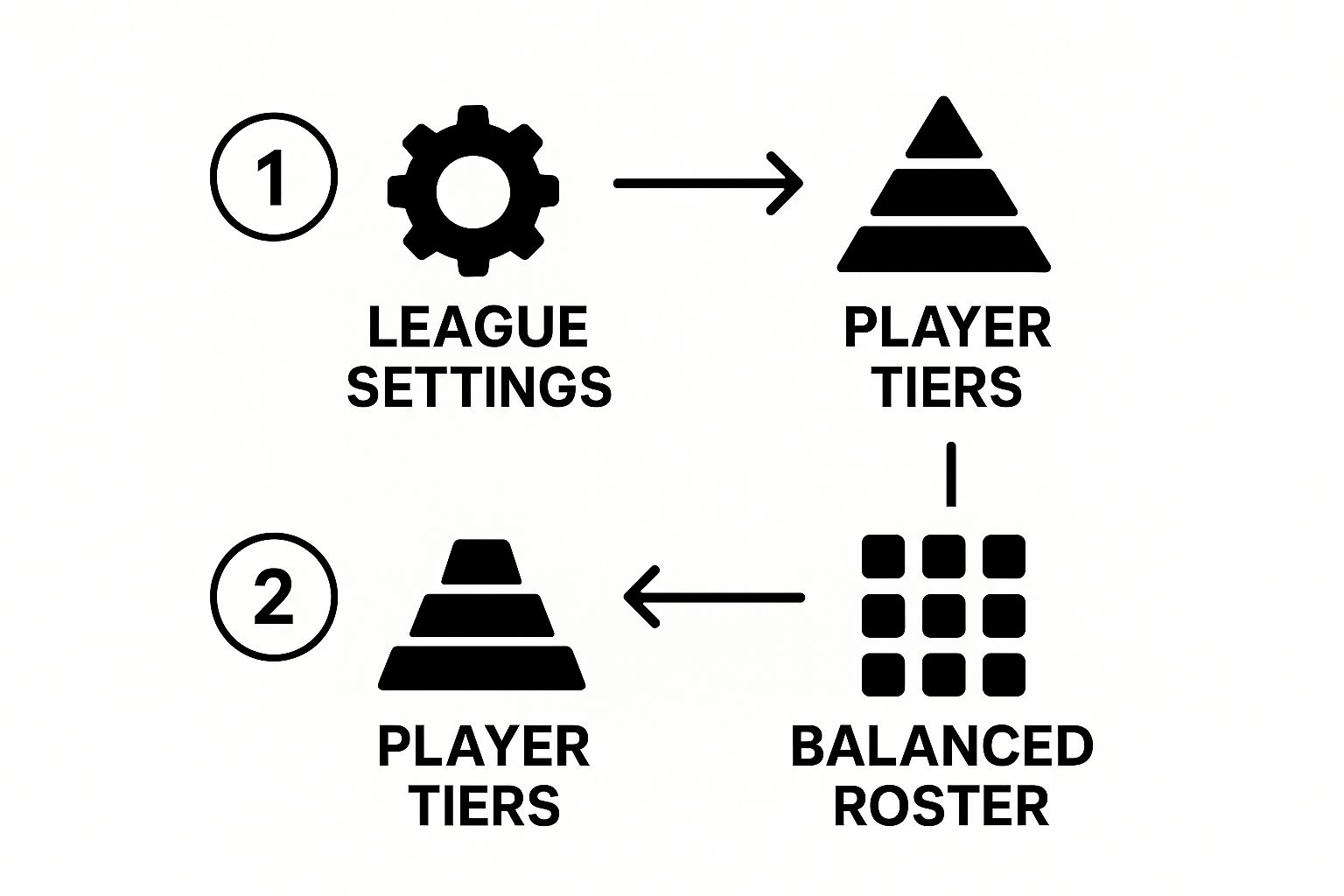
As the graphic shows, it starts with understanding your league settings and building solid player tiers. Those are the building blocks for constructing a balanced roster when the picks start flying.
Reacting to Positional Runs
It’s going to happen. You’ll watch three goalies fly off the board in five picks, or a sudden rush on right-wingers will leave the position looking dangerously thin. Don't fall into the trap. The worst thing you can do is get caught up in the frenzy and reach for a player several tiers below just to fill a spot.
Instead, use these runs to your advantage. While your leaguemates are scrambling for the last decent defenceman, you can calmly pivot and grab a top-tier forward who just fell into your lap. We call this "zagging while they zig," and it’s a cornerstone of a winning fantasy hockey draft strategy. By staying patient, you can often scoop up elite talent at a serious discount.
Key Insight: A positional run creates value elsewhere. Let your opponents chase a position while you calmly select the best player available from a different, deeper tier. This patient approach is how you build a powerhouse.
Mastering Value-Based Drafting
One of the most powerful tactics you can use in a live draft is Value-Based Drafting (VBD). The idea is pretty simple: a player’s true value isn't their raw point projection, but how much better they are than the next-best guy you could find at their position later on.
Think about it this way: a 70-point defenceman is way more valuable than a 75-point left winger. Why? Scarcity. Elite, point-producing blueliners are incredibly rare. You can easily find a 55-point winger on the waiver wire mid-season, but finding a competent offensive defenceman? Good luck.
Applying VBD in real-time means you're constantly asking yourself:
- How big is the drop-off to the next tier at this position?
- Which position is the scarcest right now?
- Am I drafting this guy because he's good, or because he gives me a massive advantage over his peers?
This mindset saves you from the common trap of just drafting the player with the highest overall point total. It helps you build a team that's structurally sound and dominant from top to bottom.
Draft Round Strategy At-A-Glance
To help put this all together, think of your draft in phases. Each part of the draft has a different goal, from grabbing elite cornerstones to finding high-upside sleepers. This table provides a quick roadmap.
| Draft Phase | Primary Goal | Typical Player Targets |
|---|---|---|
| Early Rounds (1-3) | Secure Elite Talent & Scarcity | Franchise players, top-tier goalies, elite offensive defencemen |
| Mid-Rounds (4-8) | Build Core & Fill Positional Needs | High-floor forwards, top-15 D-men, reliable secondary scorers |
| Late-Mid Rounds (9-12) | Add Depth & High-Upside Players | Power-play specialists, potential breakout candidates, solid #2 goalies |
| Late Rounds (13+) | Target Sleepers & Fill Categories | Rookies with opportunity, bounce-back veterans, shot-blocking specialists |
Remember, this is a flexible guide, not a rigid set of rules. The key is to understand what type of value you should be targeting as the draft progresses.
Tracking Your Opponents
A good drafter focuses on their own board. A great drafter watches everyone else's. Pay attention to the other rosters as they take shape. Who is weak on goalies? Who loaded up on forwards but completely ignored their defence?
Knowing what your opponents need helps you predict their next moves. If the manager picking two spots ahead of you has zero goalies and there’s only one clear starter left in a high tier, you can bet they’re taking him. This kind of foresight lets you plan your picks more effectively and potentially snag a player you thought would be long gone.
Your draft board isn't just a list of names—it's a dynamic chessboard. Staying aware of the entire game is critical for success.
Keeping Your Team Competitive All Season
Congratulations, you survived the draft. But here’s a truth every seasoned fantasy manager knows by heart: your draft-day roster is just the starting line. Championships aren't won on draft night; they're earned through relentless, week-to-week tinkering.
Don’t just close the laptop and wait for opening night. Your first moves as a manager should happen immediately, transforming that collection of drafted players into a cohesive, competitive unit.
Conducting Your Post-Draft Autopsy
The moment your draft ends is the perfect time for an honest roster assessment. Before the waiver wire chaos begins and trade offers start flying, take a clear-eyed look at what you’ve built. Where are you strong, and where are the glaring holes?
This isn’t about second-guessing your picks—it’s about identifying your team’s new identity. Did you accidentally assemble a team of pure goal-scorers who offer nothing in shots and hits? Are your goalies rock-solid but backed by a low-event, low-scoring forward group?
- Categorical Strengths: Pinpoint the 2-3 categories you are built to dominate. This is your foundation for winning weekly matchups.
- Obvious Weaknesses: Identify where you're clearly deficient. You don't need to win every category, but you can't afford to punt several of them entirely.
- Positional Imbalance: Did you go heavy on wingers and leave yourself thin at centre? Note these imbalances, as they'll guide your first waiver claims and trade targets.
This immediate analysis gives you a roadmap. It tells you exactly what kind of player to hunt for on the wire to either shore up a weakness or double down on a strength.
Mastering the Waiver Wire
The waiver wire is where leagues are won. Seriously. It’s a constant stream of opportunity, from short-term injury fill-ins to season-long breakout stars. Treating it as an afterthought is one of the biggest mistakes a manager can make.
The key is to be proactive, not reactive. Don't wait for a player to pop off for a hat trick before you notice him. You need to look for the underlying signs of a pending breakout:
- A sudden jump in ice time, especially on the power play.
- A promotion to a top-six forward line alongside elite talent.
- A significant increase in shot volume over a multi-game stretch.
Pro Tip: Set aside time every Sunday and Tuesday morning to scan the waiver wire and player news. These are typically the best days to get ahead of weekly lineup locks and pounce on deployment changes before your competition does.
By spotting these trends early, you can grab players before they become the week's hottest commodity. These small, consistent wins on the waiver wire accumulate over a season and can be the difference-maker in a tight race.
The Art of the Savvy Trade
Trading is the most direct way to overhaul your roster, but it demands patience and a sharp understanding of team needs—both yours and your opponents'. A great trade isn't about "winning" by ripping someone off; it's about finding a mutually beneficial deal that addresses weaknesses for both sides.
Start by scouting the other managers. If you're flush with goal-scoring wingers but desperate for a goalie, find the manager with three solid netminders who can't buy a goal. That's your ideal trade partner.
When you send an offer, make it logical. Explain why the trade helps their team. A classic "2-for-1" deal, where you offer two solid players for one elite one, can be a great way to open up a roster spot for a high-upside waiver pickup. To make sure you're proposing a fair deal, a good tool is invaluable. You can see how a well-designed fantasy hockey trade analyzer helps you craft smarter, more effective proposals.
Your team on the final day of the season will look very different from the one you drafted. By staying engaged, actively working the wire, and making smart trades, you give yourself the best shot to be the one lifting the virtual trophy.
At PuckNStick, we provide the deep-dive stats and analytics to help you make those winning in-season moves. Get the edge you need by visiting https://www.pucknstick.com.
